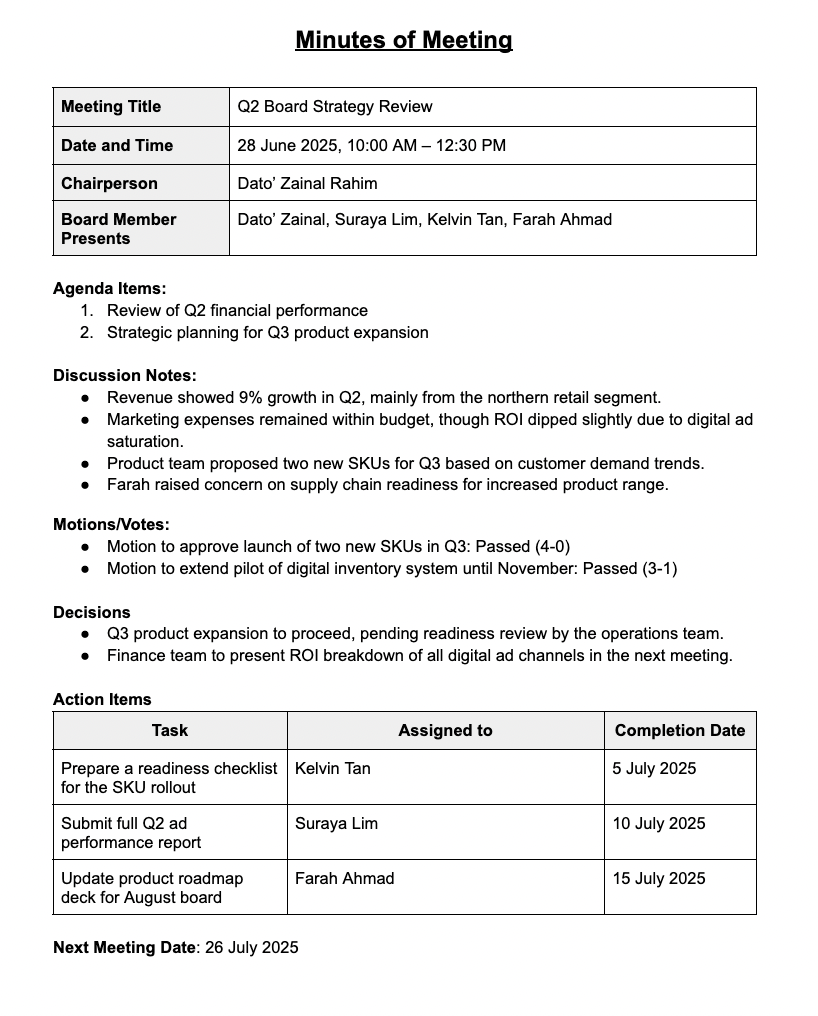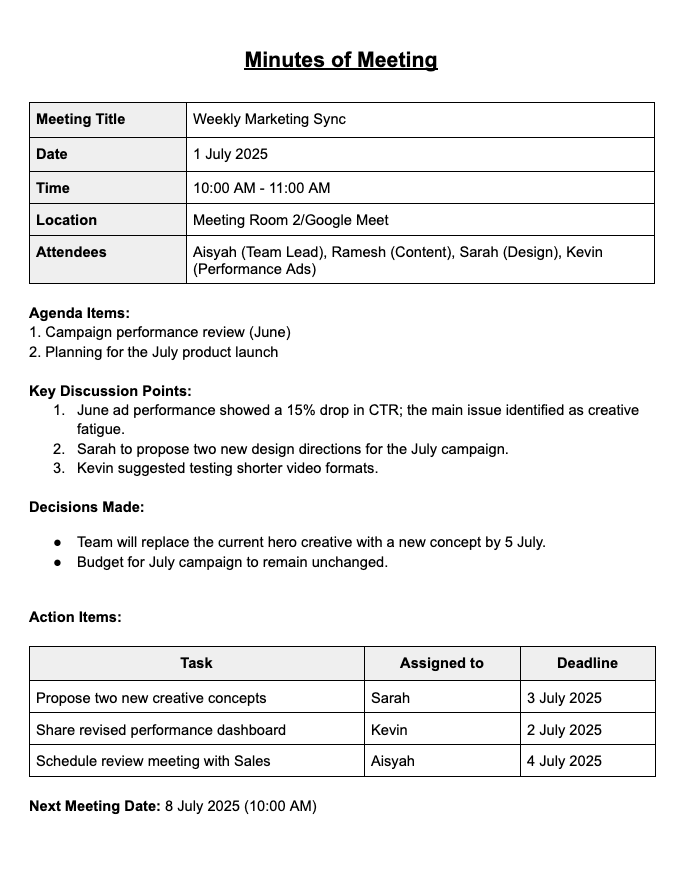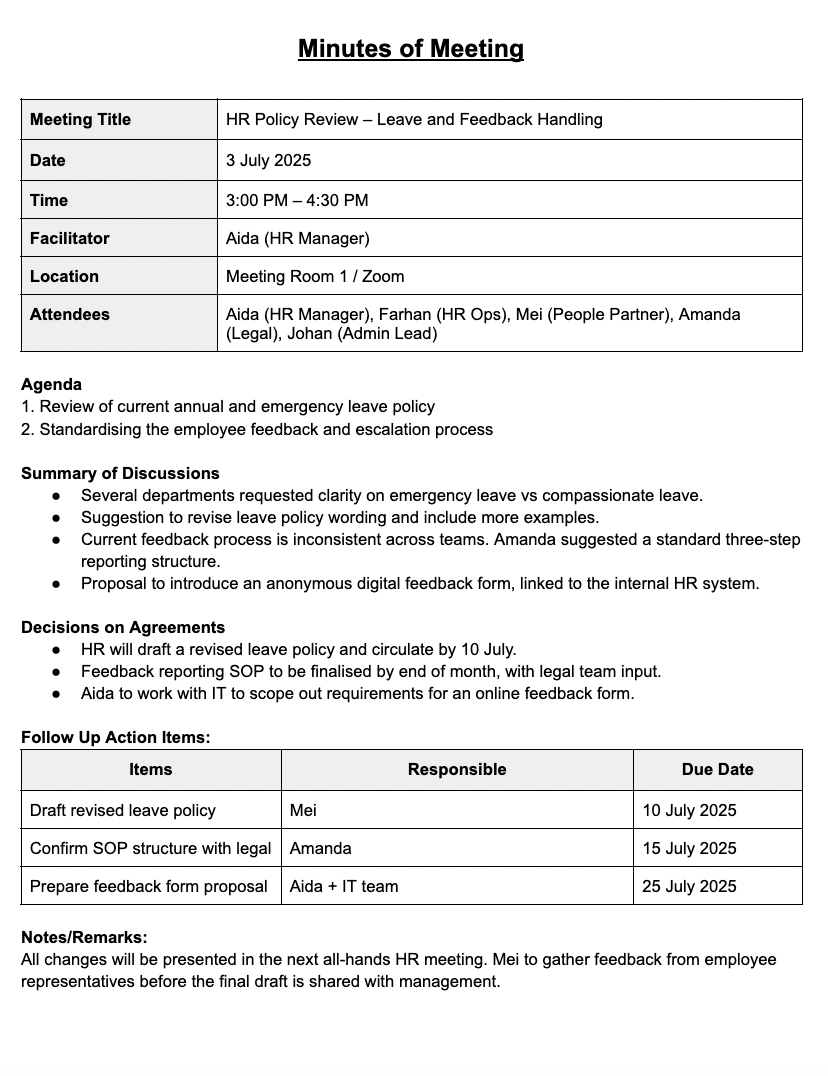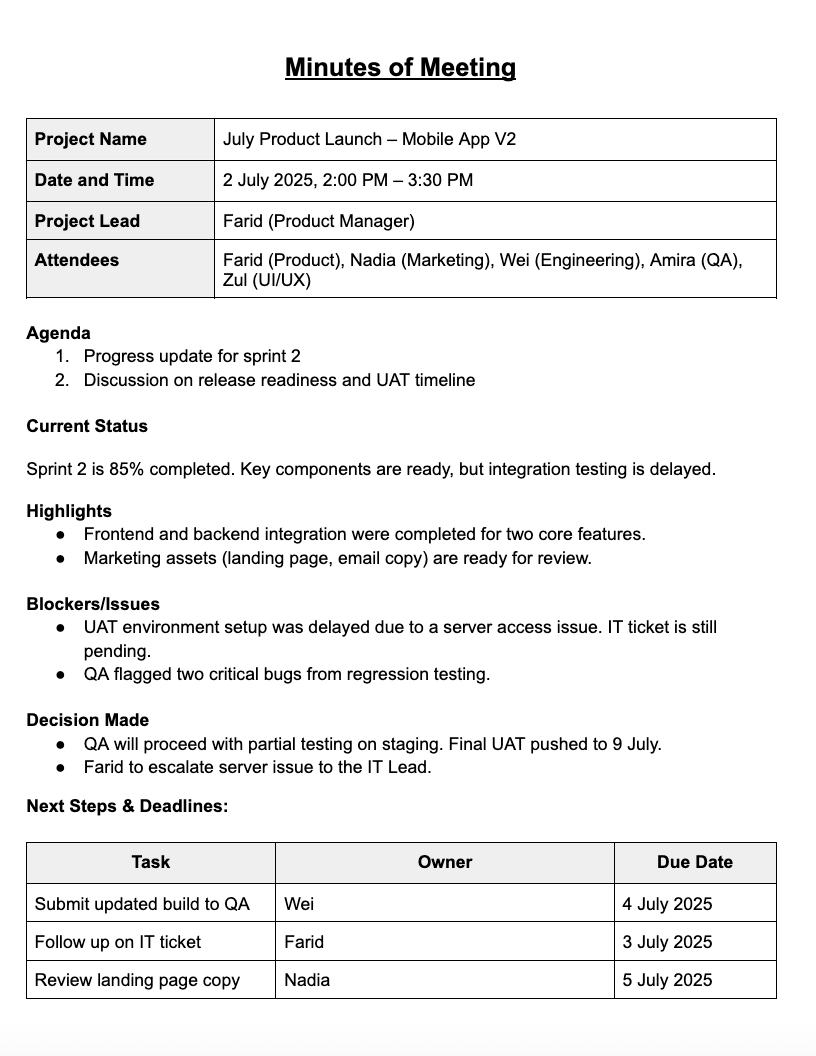
How to Write Effective Minutes of Meeting (with Free Templates)
Are You Hiring?
Find candidates in 72 Hours with 5+ million talents in Maukerja Malaysia & Ricebowl using Job Ads.
Hire NowEvery meeting needs a record as proof of the agenda and decisions made in the meeting. Usually, companies use minutes of meeting or meeting minutes.
It helps teams remember what was discussed, what actions were agreed on, and who’s responsible for what. Having an organized and clear minutes of meeting can help attendees and outside attendees to understand the decisions made and the action items.
We will share with you what is minutes of meeting, elements that should be included, and free templates for you.
What are Meeting Minutes?
In any organisation, meetings happen all the time. But without proper notes, key decisions and next steps can easily be forgotten.
To avoid forgetting the discussion points and decisions in a meeting, you need minutes of meeting. It is written records of what was discussed and decided during a meeting. They capture important points such as the date, attendees, discussion topics, action items, and decisions made. These notes help teams stay aligned, keep track of responsibilities, and provide a reference point for those who couldn’t attend.
They are especially useful for HR teams during policy updates, performance discussions, or hiring meetings. Project managers rely on them to track progress, and leadership teams use them to document decisions for accountability or audit purposes.
Meeting minutes don’t need to include every single word said. Instead, they should highlight the big picture: what was talked about, what was agreed on, and what needs to be done next.
When written properly, meeting minutes help keep everyone on the same page and prevent important details from being lost.
What to Include in Meeting Minutes
A good minutes document helps anyone understand what was discussed, what was decided, and what needs to happen next. It needs to be written in an organized and clearly way.
What should every minutes of meeting template should include?
-
Date and Time of the Meeting: To track when the meeting took place and make it easier to file and refer back to later.
-
List of Attendees: The names of people who were present. Mention their department or role to identify who was involved in key decisions or action items.
-
Meeting Agenda: The structured summary of the main topics or goals for the meeting.
-
Key Discussion Points: List of main ideas discussed for each agenda item. This doesn’t have to be too long, just enough to show what was talked about and what viewpoints were shared.
-
Decisions Made: Any decisions that were agreed on during the meeting, could be related to project directions, policy changes, or next steps.
-
Action Items: List of tasks that came out of the meeting, including who is responsible, what needs to be done, and when it should be completed.
-
Next Meeting Date (if planned): The proposed date and time to help with scheduling and follow-up.
Types of Meeting Minutes Templates (with samples)
Different meetings have different goals, and the format of your meeting minutes should match the purpose. Check out some useful types of meeting minutes templates, each suited to different situations you might face as an HR professional, team lead, or company admin.
1. Basic Meeting Minutes Template
This is the most flexible format and works for almost any kind of meeting. It covers the essentials: date, attendees, agenda items, discussion points, decisions, and action items. If you’re running regular team meetings or weekly check-ins, this simple layout is a good place to start.
2. HR Meeting Template
HR teams often need to document sensitive topics like employee concerns, disciplinary discussions, or policy reviews. This version includes space to note key talking points, agreed actions, and any follow-up timelines, while keeping the tone factual and objective. It helps keep proper records in case the issue comes up again later.
3. Project Status Meeting Template
Project meetings usually focus on progress tracking, problem-solving, and task updates. This template includes sections for project milestones, blockers, upcoming deadlines, and team responsibilities. It helps keep teams aligned and makes it easier to follow up on deliverables.
4. One-on-One Meeting Notes (Manager & Staff)
These notes help managers track employee performance, development goals, and workplace concerns. The format includes space for short-term goals, feedback shared, and any agreed-upon support or training. This type of note is especially useful for performance reviews or monthly check-ins.
5. Board or Leadership Meeting Template

Meetings with directors or senior leaders often include big-picture discussions and formal decisions. This template highlights strategic agenda items, financial or operational updates, and clear records of approvals or votes. These minutes may be used for legal, audit, or compliance purposes, so accuracy and structure matter.
Tips for Writing Effective Minutes
Meeting minutes are most helpful when they’re clear, organised, and easy to refer back to. Follow some tips below to help you write better minutes that actually get used:
Use simple and objective language
Stick to the facts. Don’t include personal opinions or assumptions. Use short, clear sentences so that anyone reading the document later can understand what happened without needing extra context.
Write during or immediately after the meeting
The sooner you write or finalise your minutes, the better. This helps you remember key points more accurately and avoids missing important details.
Double-check key details
Always confirm the correct names of attendees, dates, deadlines, and assigned tasks. These small details matter when someone needs to follow up later.
Use bullet points for readability
Bullet points make it easier to scan the document. Use them for listing discussion points, action items, or decisions so your notes are clear and to the point.
Keep a shared digital archive
Store your meeting minutes in a central folder or document system that your team can access. This helps with transparency and makes it easy to find past meeting records whenever needed.
Your Next Hire Could be Just a Click Away!
Let AJobThing help you find the right people who will grow with your company.
Post your job ads and connect with top talent across platforms like Maukerja, Ricebowl, and Epicareer today.
Read More:
- Onboarding Checklist for New Hires (Free Downloadable Template)
- Employment Induction Checklist to Improve New Hire Experience
- Employment Verification Letter: Importance, How To, Free Downloadable Templates
- How to Write an Employment Letter (With Examples & Tips)
- How to Use a Letter of Indemnity in HR and Employee Requests
- Leave Management System for Malaysian Employers – Track Leave Easily (Free Template)
- How to Create and Use an Appraisal Form in Malaysia (With Templates)
- How to Write a Professional Surat Kenaikan Gaji (with Samples)
- Step-by-Step Guide to Writing a Great Job Description (Free Templates)
- Sample Resignation Letter with One Month's Notice for Employers [Free Templates]
- 13 Free HR Templates for Various Activities in the Company
- How to Write an Employer Confirmation Letter (+ Free Samples)
- Salary Calculator for Employers in Malaysia [+FREE Template]
- Free KWSP/EPF Calculator Excel Template for Malaysian Employers
- How to Prepare a Monthly Salary Report in Malaysia (+ Free Templates)





 .png)